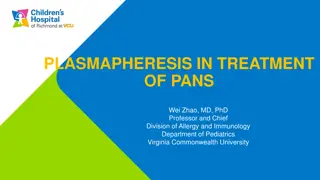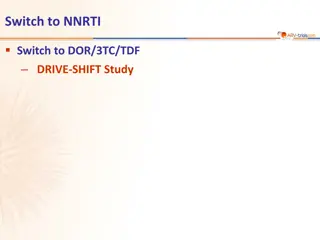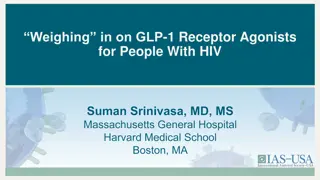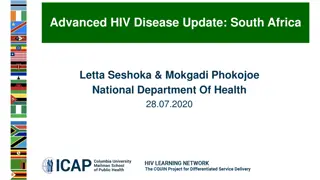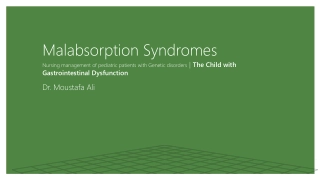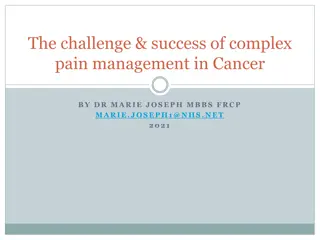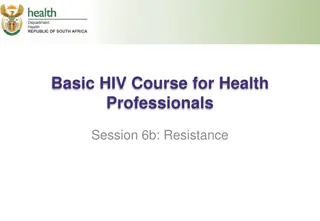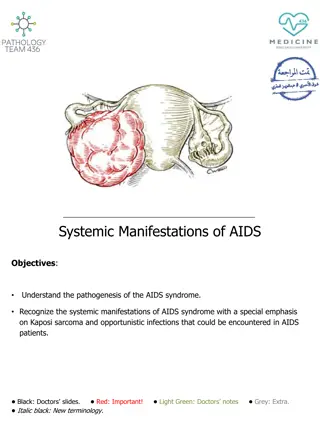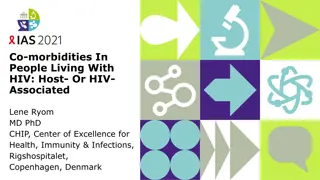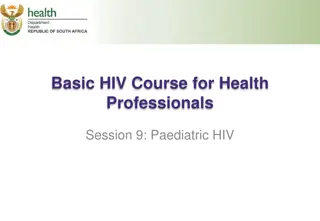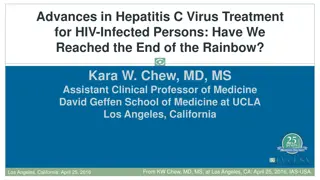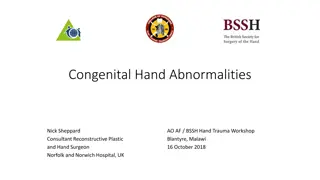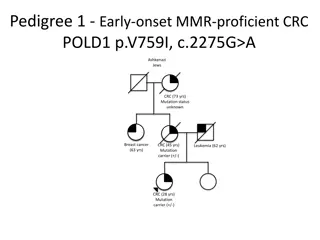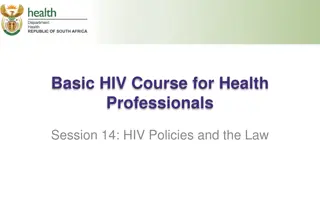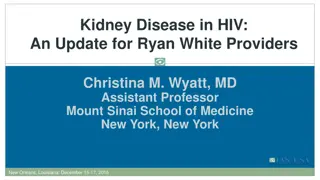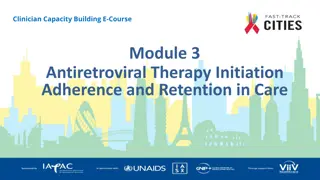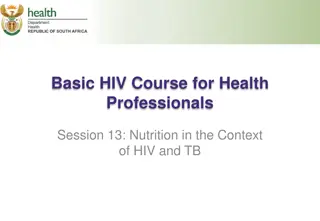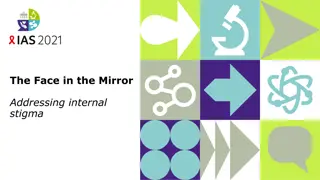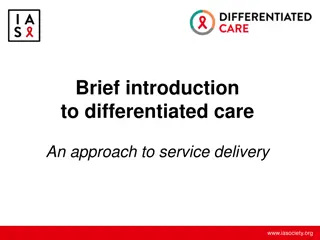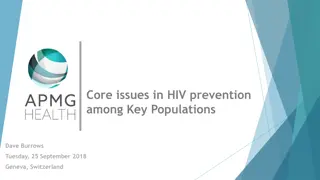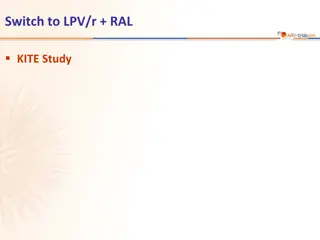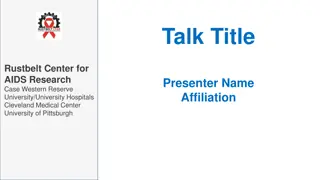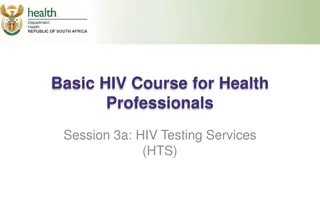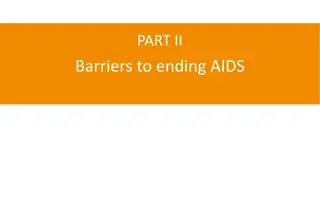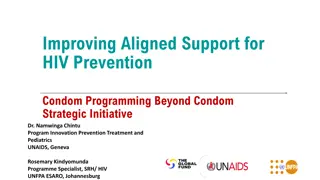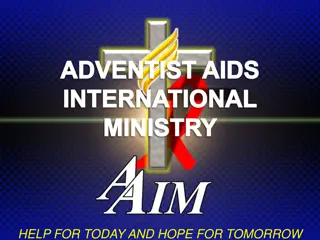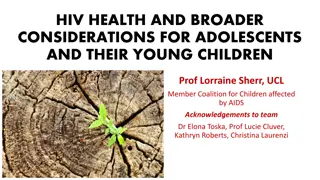Understanding Neuropsychiatric Syndromes in HIV Patients
This educational curriculum explores the role of psychiatry in enhancing outcomes for people living with HIV (PLWH) by addressing cognitive burden, psychiatric disorders prevalence, and appropriate psychopharmacology. Delving into the history, epidemiology, and psychiatry's role, the material covers psychosocial issues, antiretroviral therapy side effects, neurocognitive impairment, and drug interactions. Highlighting HIV milestones and epidemiology, it sheds light on the challenges faced by vulnerable populations.
Download Presentation

Please find below an Image/Link to download the presentation.
The content on the website is provided AS IS for your information and personal use only. It may not be sold, licensed, or shared on other websites without obtaining consent from the author. Download presentation by click this link. If you encounter any issues during the download, it is possible that the publisher has removed the file from their server.
E N D
Presentation Transcript
HIV: Neuropsychiatric Syndromes APM Resident Education Curriculum Updated 2019: Mallika Lavakumar, MD Updated 2013: Carrie Ernst, MD, & Karina Uldall, MD, MPH Original version: Karina Uldall MD, MPH, Inpatient Psychiatry and Psychosomatic Medicine, Section Head, Virginia Mason Hospital Psychiatry Consultation Service Version of March 15, 2019 ACADEMY OF CONSULTATION-LIAISON PSYCHIATRY Psychiatrists Providing Collaborative Care Bridging Physical and Mental Health
Disclosure Dr. Lavakumar is the co-investigator of a study funded by the U.S. Department of Health Research Services Administration: System-level Workforce Capacity Building for Integrating HIV Primary Care in Community Health Settings H97HA27429-01-00. Her relationship with HRSA is not considered directly relevant to the presentation. Academy of Consultation-Liaison Psychiatry
Objectives 1) Appraise the role of psychiatry in optimizing outcomes of PLWH 2) Describe the cognitive burden of HIV 3) Describe the prevalence and impact of psychiatric disorders in people living with HIV (PLWH) 4) Choose appropriate psychopharmacology in PLWH Academy of Consultation-Liaison Psychiatry
Outline History, epidemiology and role of psychiatry Psychosocial issues Antiretroviral therapy: Neuropsychiatric side effects Delirium HIV-associated neurocognitive impairment Psychiatric disorders and syndromes Drug interactions Academy of Consultation-Liaison Psychiatry 4
HIV Milestones Early 1980s first cases Mid 1980s HIV test available Late 1980s to early 1990s minimal benefit from antiretroviral therapy Time from AIDS diagnosis to death = 2 years PCP prophylaxis reduces mortality Mid 1990s Highly Active Antiretroviral Therapy (HAART) HIV/AIDS became a chronic illness Academy of Consultation-Liaison Psychiatry 5
HIV epidemiology More than 1.1 million people in the US are living with HIV as of 2018 Vulnerable populations: - Individuals with substance use disorders and mental illness - Sexual, gender, racial, and ethnic minorities https://www.aids.gov/hiv-aids-basics/hiv- aids-101/statistics/ Academy of Consultation-Liaison Psychiatry
HIV epidemiology New HIV Diagnoses in the United States for the Most-Affected Subpopulations 2010-2015 https://www.aids.gov/hiv-aids-basics/hiv-aids- 101/statistics/ Academy of Consultation-Liaison Psychiatry
HIV epidemiology - In 2016, 39,782 people in the US were diagnosed with HIV In the year 2015, 1 in 7 individuals in the US unaware of infection Men who have sex with men (MSM) bear the greatest risk of infection From 2010 2015 the rate of HIV infections declined 8% Southern states in the US have higher rates of new infections - - - - https://www.aids.gov/hiv-aids-basics/hiv-aids-101/statistics/ Academy of Consultation-Liaison Psychiatry
Psychosocial Issues in HIV Population characteristics Marginalized; minorities (ethnic, sexual and gender minorities) Stigma and discrimination Social isolation Fear of death/illness Shame Guilt Academy of Consultation-Liaison Psychiatry 9
HIV prevention strategies for patients with psychiatric disorders Routine HIV testing for high risk patients Consider encouraging and offering HIV testing as part of an initial psychiatric assessment Provide education for HIV prevention Treat psychiatric and substance use disorders Early treatment within 72 hours improves outcomes and can prevent build up of reservoirs in the brain Academy of Consultation-Liaison Psychiatry
HIV prevention strategies for patients with psychiatric disorders Encourage PrEP (pre-exposure prophylaxis) and PEP (post-exposure prophylaxis) PrEP Truvada (tenofovir + emtricitabine): daily pill to prevent HIV infection in at risk individuals At risk: HIV-negative member of serodiscordant couple Injection drug user PEP Use of antiretrovirals to prevent seroconversion after a high-risk event (sex, needle-sharing, health care work exposure) Academy of Consultation-Liaison Psychiatry
Antiretroviral Therapy: Goals Primary goal of viral suppression, <50 cells/mL Secondary goals: Immunologic restoration: improving damage done to the immune system by HIV (measured by CD4 count) Prevention of HIV-related complications Six classes of antiretroviral agents: Non-nucleoside reverse transcriptase inhibitors (NNRTIs) Nucleoside reverse transcriptase inhibitors (NRTIs) Protease inhibitors (PIs) Integrase inhibitors (ISIs) Entry inhibitors Fusion inhibitors Academy of Consultation-Liaison Psychiatry 12
Antiretroviral Therapy: Known neuropsychiatric side effects Class Medication Side Effects NNRTIs Efavirenz Insomnia, nightmares, irritability, mania, depression, psychosis, suicidal ideation Nevirapine Vivid dreams, psychosis, mood changes Rilpivirine Vivid dreams, irritability, mania, depression, psychosis NRTIs Zidovudine Anxiety, irritability, mania, psychosis Emtricitabine Insomnia, irritability, depression, and mood lability Abacavir Depression, mania and psychosis PIs Ritonavir Fatigue, dizziness Saquinavir Fatigue, psychosis, suicidal ideation ISIs Raltegravir Insomnia, nightmares, depression, mania, psychosis, dizziness Elvitegravir Suicidal ideation Academy of Consultation-Liaison Psychiatry 13
Differential Diagnoses for Psychiatric Symptoms in HIV Delirium HIV-associated neurocognitive disorders (HAND) Other HIV/AIDS neurologic Illnesses Medication toxicity Substance use Primary psychiatric illness Mood disorders Anxiety Disorders Schizophrenia Post traumatic stress disorder (PTSD) Academy of Consultation-Liaison Psychiatry 14
Delirium in HIV Clinical presentation is the same as in non-HIV-infected patients Considerations in people with HIV: CNS infections/mass lesions (toxoplasmosis, cryptococcal meningitis, progressive multifocal encephalopathy, CMV, CNS lymphoma) Pneumocystis jirovicii (pneumonia) Systemic infections Substance intoxication and withdrawal Malnutrition Metabolic abnormalities Electrolyte abnormalities Medication toxicity 15 Academy of Consultation-Liaison Psychiatry
HIV related CNS infections/mass lesions Condition Organism Risk factors Symptoms/signs Tests Treatment Toxoplasmosis Toxoplasma CD4 < 100 cells/mm3 Fever, headaches, delirium, focal neurologic signs, seizures Head CT/MRI: multiple bilateral ring-enhancing lesions CSF: T. Gondii PCR Pyrimethamine and leucovorin gondii Cryptococcal Meningitis Cryptococcus neoformans CD4 < 100 cells/mm3 Fever, delirium, meningeal signs, focal neurological signs, seizures CSF: cryptococcal antigen Amphotericin B Progressive multifocal leukoencepha lopathy JC virus CD4 < 100 cells/mm3 Focal neurological deficits, coma, death. Head CT: hypodense lesions Head MRI: hyperintense T2 images CSF: JV virus PCR Immune restoration with antiretrovirals Academy of Consultation-Liaison Psychiatry 16
HIV related CNS infections/mass lesions Condition Organism Risk factors Symptoms/signs Tests Treatment Lymphoma Not applicable CD4 < 100 cells/m m3 Focal signs, seizures Head CT/MRI: patchy lesions Chemotherapy, radiation, palliation CMV encephalitis Cytomegalo virus CD4 < 50 cells/m m3 Delirium, memory problems, motor/ sensory/ CN deficits, ataxia Head MRI: diffuse or periventricular hyperintense images on T2 CSF: CMV PCR Ganciclovir and/or foscarnet Not HIV specific but frequently co-occurring: neurosyphilis, vitamin deficiencies (e.g., B12 deficiency) Academy of Consultation-Liaison Psychiatry 17
Delirium in HIV: Work-up Focused neurologic exam Labs: complete blood count, basic metabolic panel, hepatic panel, VDRL, FTA-ABS, B12, folate MRI to evaluate for HIV related CNS process Lumbar puncture to evaluate for CNS infections or mass lesions Review of medications EEG Academy of Consultation-Liaison Psychiatry 18
Delirium in HIV: Treatment Identifying and treating underlying problem Non-pharmacological interventions are similar to general management of delirium: reorientation mobilization minimizing sleep interruptions noise reduction addressing sensory deprivation (e.g., providing hearing aids or glasses) Academy of Consultation-Liaison Psychiatry 19
Delirium in HIV: Treatment Antipsychotics are used in the setting of combative behavior/emotional distress due to perceptual disturbances Patients with advanced HIV are sensitive to neuroleptic-induced EPS (may be the result of basal ganglia damage caused by HIV infection) Use low doses of high potency antipsychotics in patients with advanced HIV Academy of Consultation-Liaison Psychiatry 20
HIV-Associated Neurocognitive Disorders (HAND) Affects survival, QOL, functioning Screening tests include the HIV Dementia Scale and Modified HIV Dementia Scale Diagnosis of exclusion A combination of history, examination, and neuropsychological testing can confirm the diagnosis MRI: atrophy, abnormalities in the basal ganglia, and frontal white matter Heaton et al, J Neurovirol, 2011 Academy of Consultation-Liaison Psychiatry
HAND: Classification HAND Type Prevalence in CART treated individuals Diagnostic Criteria Asymptomatic Neurocognitive Impairment (ANI) 30% - 1 std deviation below the mean on 2 neurocognitive domains - no functional impairment Mild Neurocognitive Disorder (MND) 20%-30% - 2 SD below the mean on 2 neurocognitive domains - Mild to moderate interference in daily functioning HIV Associated Dementia (HAD) Formerly known as AIDS dementia complex, HIV encephalitis, HIV encephalopathy 2%-8% - S2 D below the mean on 2 neurocognitive domains - Marked impairment in daily functioning Antinori et al, Neurology, 2007 Academy of Consultation-Liaison Psychiatry 22
HAND: Prevalence Pre ART Post ART The more severe forms of HAND are less prevalent in ART era ANI = Asymptomatic neurocognitive impairment MND = Minor neurocognitive disorder HAD = HIV-associated dementia Grant et al, Neurology, 2014 Academy of Consultation-Liaison Psychiatry
HAND: Risk Factors Low CD4 nadir Advanced age Hepatitis C Comorbidity Substance abuse, particularly amphetamines Cerebrovascular risk factors (diabetes mellitus, hypertension, hypercholesterolemia) Psychiatric disorders (major depression, bipolar disorder, anxiety disorders) Sleep disorders Academy of Consultation-Liaison Psychiatry
HAND: Pathogenesis CNS inflammation can lead to neurodegeneration HIV can cause direct neurotoxicity The brain is a pocket reservoir for HIV persistence, despite peripheral viral suppression Abnormal glutamate homeostasis: disruption of brain glutamate metabolism and neurotransmission Saylor D et al, Nat Rev Neurol, 2016 Academy of Consultation-Liaison Psychiatry
HAND: Clinical Features Executive dysfunction Memory Disruption of attention Processing speed Multitasking Impulse control Judgment Academy of Consultation-Liaison Psychiatry
HIV-associated dementia: Treatment Viral suppression with ART Symptom management Symptom management Encourage to remain appropriately active Medication adherence assistance Structured routines Determine level of supervision Memory aids Identify supports Simplify complex tasks (e.g., drug regimens) Fall prevention Write instructions for patients and caregivers Familiar environments Cognitive skills building Academy of Consultation-Liaison Psychiatry 27
Depression in HIV: Prevalence HIV Cost and Services Utilization Study (HCSUS): 36% screened positive 22% prevalence on full diagnostic assessment Bing et al, Arch Gen Psychiatry, 2001 Orlando et al, . Int J Methods Psychiatr Res, 2002 MMP: Major depression: 12.4% highest in women, transgender patients, income < $10,000, and <HS education Do et al, Plos One, 2014 Point prevalence of major depression: 28% 43% had a recurrent episode Choi et al, PLoS One, 2016 Academy of Consultation-Liaison Psychiatry
Depression in HIV: Impact Non-adherence to CART Non-attendance at medical appointments Non-engagement with providers Poor care for co-morbid medical conditions Increased risk of contracting and transmitting HIV Academy of Consultation-Liaison Psychiatry
Depression in HIV: Impact Substantial burden in older HIV-infected adults Milanini B, AIDS Care, 2017 Depression associated with higher mortality in gay men: RR 1.67; 95% CI, 1.01-2.78 Mayne et al, Arch Intern Med, 1996 Correlated with higher mortality in women: RR 2.0 (95% CI, 1.0-3.8) Ickovics et al, JAMA, 2001 Correlated with accelerated disease progression Lesserman et al, Psychosom Med, 1999 Depression was negatively associated with quality of life in older adults with HIV Millar et al, AIDS Behav, 2016 Academy of Consultation-Liaison Psychiatry
Depression in HIV: Screening Validated screening tools: Center for Epidemiologic Study Depression Scale (CES-D) Hospital Anxiety Depression Scale (HADS) Beck Depression Inventory (BDI) Hamilton Depression Rating Scale (HDRS) Patient Health Questionnaire (PHQ-9) Academy of Consultation-Liaison Psychiatry
Depression in HIV: Treatment Treating depression is as effective as it is in medically healthy patients Primeau et al, Psychosomatics, 2013 Sertraline, citalopram, escitalopram, mirtazapine, venlafaxine, and duloxetine are safe and effective with low likelihood of drug interactions. Testosterone (in men), stimulants, and modafinil for fatigue Emerging evidence for measurement based and collaborative care strategies Pyne et al, Arch Intern Med, 2011 Pence BW et al, AIDS, 2015 Academy of Consultation-Liaison Psychiatry
Depression in HIV: Psychotherapy Individual and group CBT effective for depression Safren et al, Lancet HIV, 2016 Safren et al, J Consult Clin Psychol, 2012 Blanch et al, Psychother Psychosom, 2002 Lee et al, Psychiatr Services, 1999 Academy of Consultation-Liaison Psychiatry
Mania in HIV: Differential Diagnosis Differential Diagnosis: HIV-associated dementia Substance intoxication/withdrawal CNS infection/tumor Medication effects Bipolar disorder Academy of Consultation-Liaison Psychiatry 34
Mania: Work-up Work-up: Personal and family psychiatric history CD4 count and viral load Urine toxicology screen Medication review Brain MRI CSF and neuropsychological testing if history is atypical (late onset, no family history, and cognitive complaints) Academy of Consultation-Liaison Psychiatry 35
Bipolar Disorder: Prevalence and Impact Approximately 8% prevalence Difficult to treat sub-populations Poor psychotropic medication adherence Poor retention in HIV care High rates of abandonment of ART Non-adherence to ART can lead to increases in community viral load Increased impulsivity and risk taking behaviors Accompanied by substance abuse de Sousa Gurgel et al, AIDS Care 2013 Perretta et al, J Affect Disord, 1998 Casaletto et al, Int J Psychiatry Med, 2016 Academy of Consultation-Liaison Psychiatry
Bipolar Disorder: Treatment Lithium Poorly tolerated in organic manic syndromes and advanced HIV No drug interactions with antiretrovirals and can be used safely in asymptomatic HIV Cruess et al, Biol Psychiatry, 2003 Halman et al, J Neuropsychiatry Clin Neurosci, 1993 Valproic Acid Well tolerated in cases when lithium is not Halman et al, J Neuropsychiatry Clin Neurosci, 1993 Lamotrigine No case reports, cohorts or trials Well tolerated Carbamazepine contraindicated due to drug interactions Academy of Consultation-Liaison Psychiatry
Psychosis: Differential Diagnosis Differential diagnoses: Delirium HIV-associated dementia Substance intoxication/withdrawal CNS infection/tumor Medication effects Psychiatric disorder: Schizophrenia/schizoaffective disorder/depressive or bipolar disorder with psychosis Academy of Consultation-Liaison Psychiatry
Psychosis: Epidemiology Schizophrenia prevalence estimated at 4% of people living with HIV/AIDS Comorbid substance abuse is major driver in increased risk of HIV in patients with schizophrenia Hellerberg et al, Lancet HIV, 2015 Prince et al, Psychiatric Serv, 2012 Academy of Consultation-Liaison Psychiatry
Psychosis: Work-up Work-up: Personal and family psychiatric history CD4 count and viral load Urine toxicology screen Medication review Brain MRI CSF, EEG, and neuropsychological testing if history is atypical (late onset, no family history, cognitive and neurologic problems are present) Academy of Consultation-Liaison Psychiatry 40
Psychosis: Treatment No clinical trials for schizophrenia or bipolar disorder Most first and second generation antipsychotics are tolerated Long-acting injectables helpful for patients unable to adhere to medication regimens Patients with advanced HIV are sensitive to neuroleptic-induced EPS (may be the result of basal ganglia damage caused by HIV infection) Use low doses of high potency antipsychotics in patients with advanced HIV Antipsychotics increase risk for metabolic syndrome, which patients with HIV are at increased risk due to HIV lipodystrophy syndrome and protease inhibitors Regular monitoring for metabolic syndrome is recommended Antipsychotics can prolong Qtc interval; certain protease inhibitors can prolong Qtc interval Baseline ECG and ECG at regular intervals is recommended Hill and Kelly, Ann Pharmacotherapy, 2013 Blank et al, Current HIV/AIDS Reports, 2013 Academy of Consultation-Liaison Psychiatry
PTSD: Epidemiology 35% 64 % prevalence Kimerling et al, AIDS Educ Prev, 1999 Safren et al, AIDS Patient Care STDs, 2003 Impact Comorbid depression and substance use disorders Adherence to ARVs Immune functioning High risk sexual behavior Academy of Consultation-Liaison Psychiatry 42
PTSD: Treatment Psychotherapy: Prolonged exposure (RCT) - effective Pacella et al, Current Psychiatry Rep, 2012 Coping skills group (Living in the face of trauma [LIFT]) effective Group psychotherapy for people with HIV who experienced sexual abuse Sikkema et al, AIDS Beh, 2004, 2007, J Consult Clin Psychol, 2013 Academy of Consultation-Liaison Psychiatry
Trauma Informed Care Create a sense of safety in all interactions with staff Screen for and identify trauma and sequelae Educate about the relationship between trauma and HIV infection Involve patient supports in treatment planning Make referrals for trauma-specific treatment Avoid restraints and seclusion in inpatient setting Brezing C et al, Psychosomatics, 2015 Academy of Consultation-Liaison Psychiatry
Substance Use in HIV: Risk factor for HIV transmission Injection drug use is a significant cause of HIV transmission Substance abuse impacts decision-making and thereby, transmission Accounts for much of the rates of HIV in severely mentally ill Academy of Consultation-Liaison Psychiatry 45
Substance Use in HIV: Impact Risk factor for HAND Negatively affects ART adherence Can complicate management of pain syndromes in HIV (e.g., HIV neuropathy) Can account for psychiatric symptoms Academy of Consultation-Liaison Psychiatry 46
Substance Use in HIV: Treatment Opioid substitution (methadone and buprenorphine reduce risk of transmission) Academy of Consultation-Liaison Psychiatry 47
Drug Interactions Drug-interactions can either lead to subtherapeutic levels of medications and decreasing effectiveness of medication OR Supratherapeutic levels of medication and cause toxicity. Generally, monitoring for ineffectiveness of a drug or for toxicity and modifying dose accordingly is suggested Academy of Consultation-Liaison Psychiatry 48
Drug interactions Class Medication Pharmacokinetics Interaction Protease inhibitors Atazanavir Darunavir Fosempranavir Indinavir Lopinavir/ Ritonavir Nelfinavir Saquinavir Tipranavir Metabolized by CYP3A4; Increase serum levels of antipsychotics dependent on 3A4*, triazalobenzodiazepines**, oral contraceptives, St. John s Wort, methadone, carbamazepine, oxcarbazepine, buspirone, trazadone, vilazodone, hypnotics***, suvorexant metabolized by ? Induce and inhibit CYP3A4 enzymes and P-glycoproteins * aripiprazole, iloperidone, lurasidone, quetiapine, ziprasidone ** alprazolam, midazolam, triazolam *** zaleplon, zolpidem, eszopiclone FDA advisory that Latuda should not be administered with a strong CYP 3A4 inducer or inhibitor Academy of Consultation-Liaison Psychiatry 49
Drug Interactions Class Medication Pharmacokinetics Interaction Protease inhibitors Ritonavir Metabolized by CYP3A4; Ritonavir is a dual inhibitor and inducer; may increase and then decrease levels of psychotropic drugs in previous table; Induce and inhibit CYP3A4 enzymes and P- glycoproteins Ritonavir also leads to increased levels of fluoxetine, paroxetine, tricyclic antidepressants, aripiprazole, asenapine, risperidone, clozapine, iloperidone Inhibits CYP 2D6 and 1A2 Fluoxetine and paroxetine lead to increased levels of ritonavir Ritonavir reduces olanzapine level Academy of Consultation-Liaison Psychiatry 50





